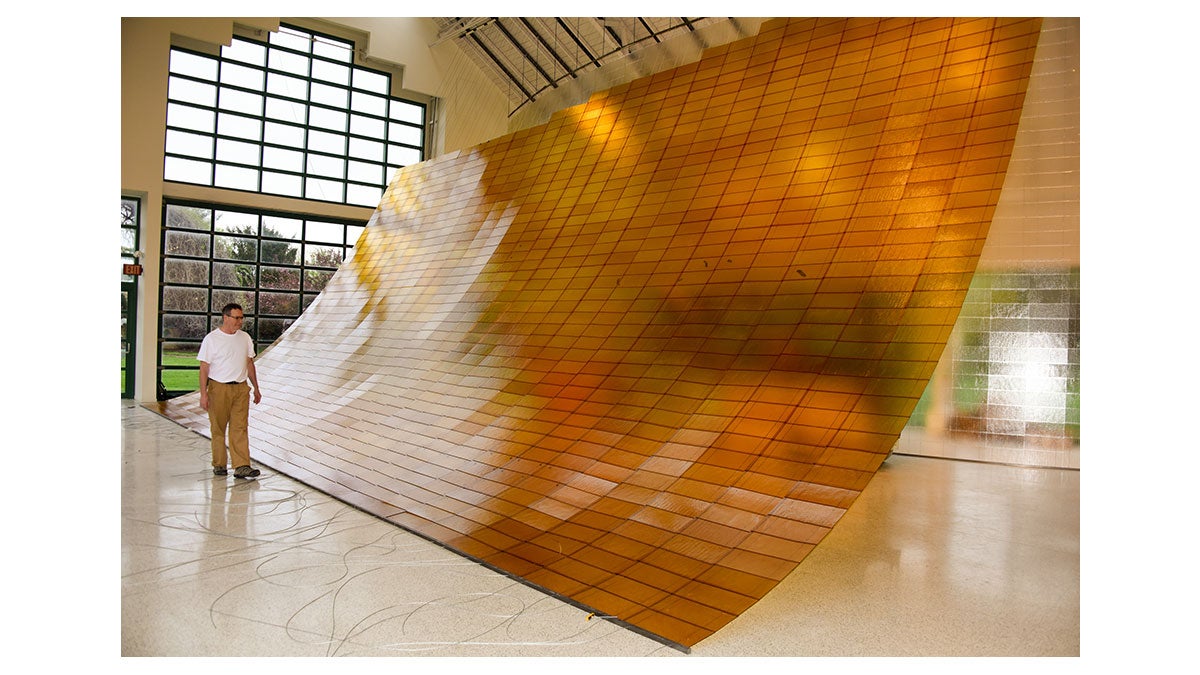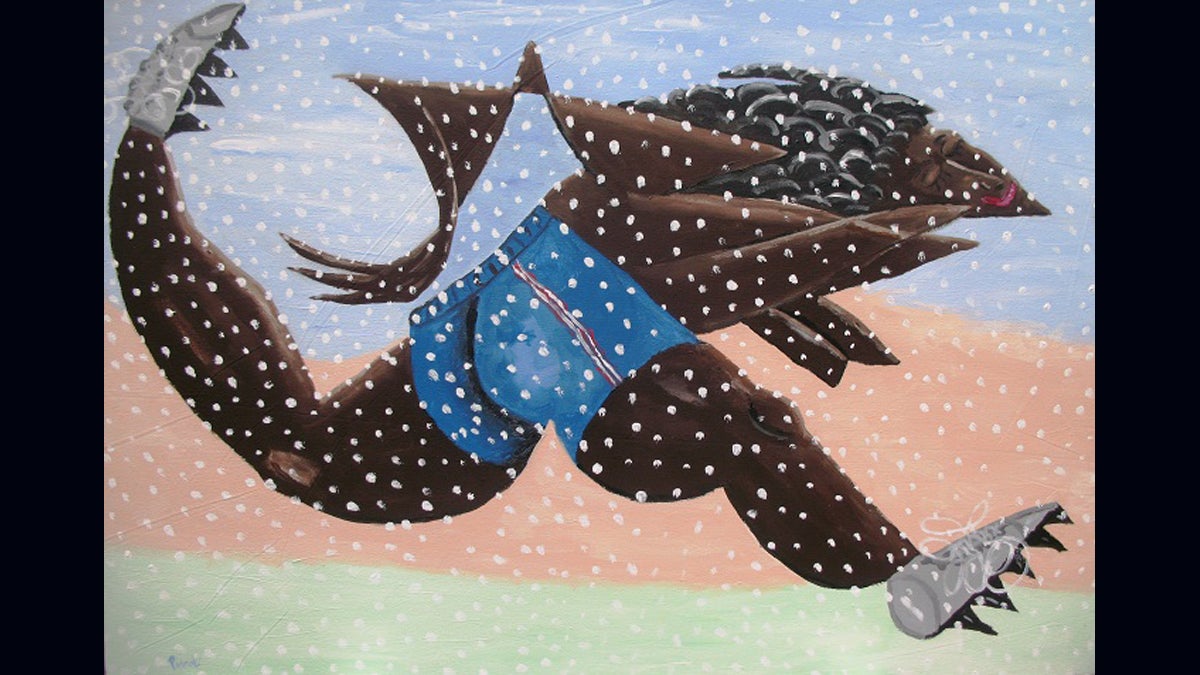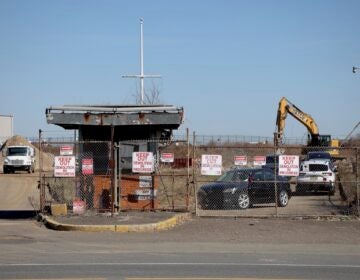Raising the glass ceiling at Grounds for Sculpture

Daniel Clayman, Radiant Landscape (installation in progress), 2017, glass, cable, steel, 26 x 44 x 26 feet, Collection of the Artist, photo: David W. Steele
His name is Daniel Clayman, but I keep thinking of him as Glassman.
On a hot and muggy afternoon, the glass man descended from a scissor lift in Grounds For Sculpture’s Museum Building to talk about his installation. Radiant Landscape, on view through February 2018, is comprised of three elements: “Amber Drape,” a cascading curve of amber-colored glass tiles that consumes most of the building’s main gallery; “Contracurve,” a similarly structured wall of glass tiles that catches the light, and color reflection, from “Amber Drape”; and “Blue Horizon,” a blue glass sky made from glass tiles stitched together, overhead. It creates the feeling of being underwater.
By day, the amber drape colors the marble floor beneath it; at sunset, “Contracurve” turns amber. Glassman — I mean Clayman — shows a snapshot of GFS Chief Curator Tom Moran standing alongside him at nightfall, peering into to the illuminated installation, showing yet another perspective from which it can be appreciated. Clayman wants people to feel as they do at sunset, as the light comes through the trees, illuminating a summer meadow. “I want to trigger a memory, a feeling,” he said.
From his studio in East Providence, R.I., Clayman conceived the design, using three-dimensional rendering software to draw the schematic. The glass was ordered from Bullseye Glass in Portland, Oregon. “It is rolled out of a furnace onto a water-cooled table in sheets, then rippled,” said Clayman, who sent his studio manager, Ruby Dorchester, to oversee the process. The glass was crated and shipped to Rhode Island where it was hand cut. “It’s the sharp edge that picks up the amber color,” he said.
Crates were made to fit the glass, in sizes small enough to be lifted. The pine crates alone are a major undertaking. Everything was carefully packed and labeled, and on April 7, along with tool cabinets, loaded onto a semi sent by Grounds For Sculpture. Clayman spent three weeks in residence, living above Rat’s Restaurant, working with a crew of about seven.
“I obey all the labor laws,” he points out. Dorchester kept hydrated, drinking from a plastic water bottle while working on scaffolding high up in the heat-collecting atrium of the museum building. Clayman considers himself a “super safety nut,” requiring everyone to wear safety glasses and hard hats, and it’s not just for staff — a Grounds For Sculpture engineer vets everything for visitor safety.
The crew includes students he worked with during his installation at Massachusetts College of Art and Design (“Rainfield” was made up of 10,000 handmade glass raindrops forming a Roman arch).
“To work with me you have to have aptitude and attitude,” he said. The former, he can teach. The attitude he seeks is “someone who can leave their ego at the door — this is my piece. And they have to be able to think on their feet and have the ability to be pleasant through the long hours of work.”
And while he maintains humane working conditions for his staff, Clayman admits he works 24/7. “It’s at the forefront of my brain even when I go to sleep,” he said. The idea for “Rainfield,” for example, came in a flash. “A soaking wet flash as I walked through a rainstorm in downtown Providence.” With “Rainstorm,” he wanted the viewer to embrace the beauty of a gathering storm.
“I want the visitor to look up, just like I did at the Cathedral at Chartres, and experience the unexpected.”
The glass tiles for “Amber Drape,” “Contracurve” and “Blue Horizon” all had to be “stitched” together. To do this, Clayman had to make 17,000 specialized wire ties. Each copper wire gets individually torched at 2,000 degrees, and as it is cooling Clayman uses the hot copper tip to make drawings. “Each mark is intentional, including the burned holes, making a record of Radiant Landscape’s creation,” he said. And while the process of making 17,000 rivets may seem tedious, Clay said he’s most happy doing this work. The drawings, complete with burn holes in BFK Rives paper, are part of the exhibition. “If they didn’t already think I’m insane, this is proof.”
 Upstairs, “Thee Volumes” was cast from remelt — a byproduct from a Pennsylvania lightbulb company — stacked, and glued in layers. Outside the building are three faceted-beveled-glass boulders, lined with gold, copper and silver leaf. Each is a monoprint from an original boulder.
Upstairs, “Thee Volumes” was cast from remelt — a byproduct from a Pennsylvania lightbulb company — stacked, and glued in layers. Outside the building are three faceted-beveled-glass boulders, lined with gold, copper and silver leaf. Each is a monoprint from an original boulder.
During the entire 24-day installation, Clayman reports, only two pieces of glass broke. That alone inspires awe.
WHYY is your source for fact-based, in-depth journalism and information. As a nonprofit organization, we rely on financial support from readers like you. Please give today.





